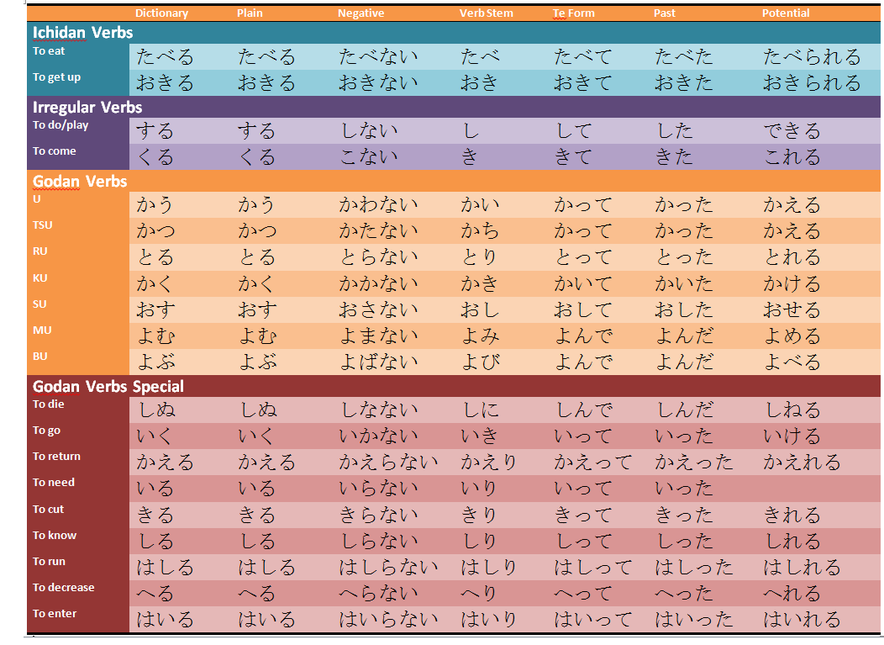The Advanced Verb Chant Chart
So I imagine you're familiar with the original Verb Chant Chart. If you're not, then this may be a little confusing. Here's our original chart:
And here is the new, improved, more advanced version.
How to add to the Chart
What happens if you want to know the past-tense of 'to sleep' - neru? You have to add it to the table. To do that, you must run through the checklist:
1) Is it する / くる ? Then it's an irregular verb.
2) Is it in the Godan Special list? Have a look!
3) Is it いる / える ? Then it's an Ichidan verb.
4) If your verb gets to this point, it's a godan verb.
Now, you may not know how to run a verb through the checklist. So I'll explain it to you now.
1) Is it する / くる ? Then it's an irregular verb.
So if the verb is する / くる, then your work is done. Look up to Irregular verbs in our table, and find the verb that you want!
2) Is it in the Godan Special list? Have a look!
It's the same as 1) - if it's in there, your work is done.
3) Is it いる / える ? Then it's an Ichidan verb.
Before you do anything, if your verb does not end in ru る, then skip this.
This is a little more complicated. Let's use TABERU (to eat) for our example.Look at taberu: たべる. It's made up of TA (which we'll ignore because it's not important for what we're about to do), BE and RU. If you split up the BE, you get B and E. Let's look at our checklist again: 3) Is it いる / える ? Then it's an Ichidan verb.
So we've got BERU. Take off the B, and we've got E RU (える). That's on the checklist! So, let's check this with our to sleep verb. NE is N and E. So it's ERU. And ERU is on the checklist! So we go to Ichidan verbs, and take off TABE for example, and replace it with our verb: NERU. So this is what the NERU like will look like on the checklist:
NERU, NERU, NERANAI, NE, NETE, NETA, NERARERU.
Yay, done!
4) If your verb gets to this point, it's a godan verb.
What happens if we have a verb that isn't an irregular, godan special or ichidan verb? We have a Godan verb. We do the same as what we do for 3). We'll use the verb nomu, which means to drink. It IS a godan verb, so it's a good example.
Take off the first part of nomu, so we get mu. Find mu in the Godan verbs list, and put it in! So it will look like:
NOMU, NOMU, NOMANAI, NOMI, NONDE, NONDA, NOMERU.
Wow, we've done a lot. We've seen the advanced Verb Chant Chart, we saw how we can add to it, and now we can add to it! Well done!
1) Is it する / くる ? Then it's an irregular verb.
2) Is it in the Godan Special list? Have a look!
3) Is it いる / える ? Then it's an Ichidan verb.
4) If your verb gets to this point, it's a godan verb.
Now, you may not know how to run a verb through the checklist. So I'll explain it to you now.
1) Is it する / くる ? Then it's an irregular verb.
So if the verb is する / くる, then your work is done. Look up to Irregular verbs in our table, and find the verb that you want!
2) Is it in the Godan Special list? Have a look!
It's the same as 1) - if it's in there, your work is done.
3) Is it いる / える ? Then it's an Ichidan verb.
Before you do anything, if your verb does not end in ru る, then skip this.
This is a little more complicated. Let's use TABERU (to eat) for our example.Look at taberu: たべる. It's made up of TA (which we'll ignore because it's not important for what we're about to do), BE and RU. If you split up the BE, you get B and E. Let's look at our checklist again: 3) Is it いる / える ? Then it's an Ichidan verb.
So we've got BERU. Take off the B, and we've got E RU (える). That's on the checklist! So, let's check this with our to sleep verb. NE is N and E. So it's ERU. And ERU is on the checklist! So we go to Ichidan verbs, and take off TABE for example, and replace it with our verb: NERU. So this is what the NERU like will look like on the checklist:
NERU, NERU, NERANAI, NE, NETE, NETA, NERARERU.
Yay, done!
4) If your verb gets to this point, it's a godan verb.
What happens if we have a verb that isn't an irregular, godan special or ichidan verb? We have a Godan verb. We do the same as what we do for 3). We'll use the verb nomu, which means to drink. It IS a godan verb, so it's a good example.
Take off the first part of nomu, so we get mu. Find mu in the Godan verbs list, and put it in! So it will look like:
NOMU, NOMU, NOMANAI, NOMI, NONDE, NONDA, NOMERU.
Wow, we've done a lot. We've seen the advanced Verb Chant Chart, we saw how we can add to it, and now we can add to it! Well done!



